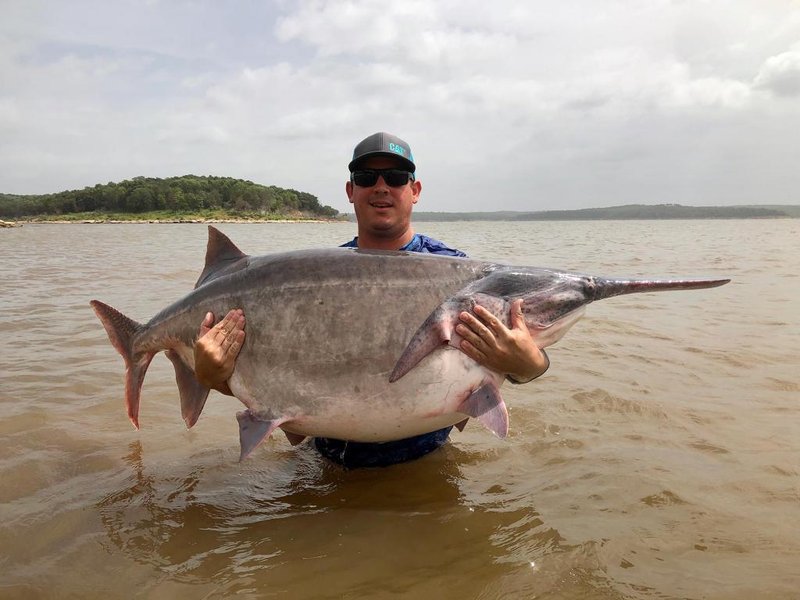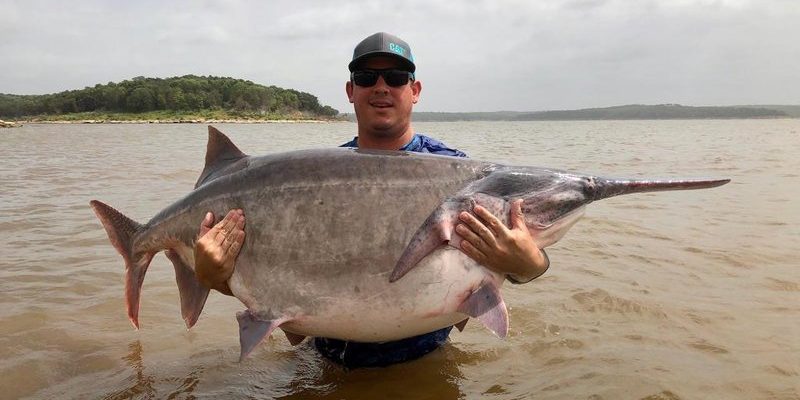
Paddlefish are fascinating creatures that have been swimming in our waters for millions of years. Imagine a fish that looks like it came straight out of a prehistoric storybook—that’s the paddlefish for you! With their distinctive long, flat snouts resembling paddles, these fish are not only unique in appearance but also in their biology, behavior, and habitat. They typically inhabit rivers and lakes in North America and Asia. But there’s much more to these ancient fish than just their paddle-like snout.
These creatures are part of the family Polyodontidae, which links them to some of the oldest fish species still swimming today. You might be surprised to learn that paddlefish are closely related to sturgeons, which makes them part of a lineage that stretches back over 300 million years! So, when you see a paddlefish, you’re not just looking at a fish; you’re witnessing a living piece of history.
Physical Characteristics
One of the most striking features of the paddlefish is their elongated, paddle-shaped snouts, which can reach up to one-third of their total body length. This unique adaptation isn’t just for show; these snouts are packed with sensitive electroreceptors that help the fish detect food in murky waters. Think of it as their personal high-tech radar—allowing them to sense the tiniest movements of prey, which usually consists of tiny zooplankton and other small aquatic organisms.
Paddlefish can grow quite large, weighing up to 200 pounds and measuring over 6 feet long! Their bodies are streamlined and covered in smooth, scaleless skin, which helps them glide effortlessly through the water. The coloration is also quite interesting; they are usually a bluish-gray on top with a lighter belly, providing effective camouflage against predators lurking above and below.
Interestingly enough, paddlefish have a cartilaginous skeleton, much like sharks and rays. This feature makes them lighter in the water, enhancing their swimming abilities. Their fins are also uniquely adapted for maneuverability, which allows them to make quick and agile turns to evade predators or chase down prey.
Habitat and Distribution
Paddlefish primarily inhabit freshwater rivers and lakes in North America and East Asia. In the United States, they are most commonly found in the Mississippi River basin, where they swim upstream to spawn. They thrive in large bodies of water, where they can roam freely and forage for food. However, they prefer areas with slow-moving water rich in plankton.
You might be wondering what kind of environment paddlefish need. They typically enjoy deep, warm waters, and they often seek out areas with plenty of vegetation. This provides both shelter and a plentiful source of food. Unfortunately, paddlefish populations have declined in many areas due to habitat loss and pollution, making conservation efforts critical for their survival.
In recent years, scientists have worked hard to restore paddlefish populations by implementing breeding programs and creating protected areas within rivers. These efforts are essential not only for the paddlefish but also for maintaining the balance of the ecosystems they inhabit. It’s a tough battle, but there is hope as awareness grows about the importance of protecting these ancient fish.
Diet and Feeding Habits
Paddlefish are filter feeders, which means they consume small organisms by swimming with their mouths open, capturing everything that comes their way. Their diet mainly consists of zooplankton, particularly a type called cladocerans. Imagine opening a large net and scooping up tiny snacks as you glide through the water—this is essentially how paddlefish dine!
During the spring and summer months, when zooplankton populations peak, paddlefish can be seen feeding near the surface. They rely on their paddle-shaped snouts to sense food in the water. This method of feeding is incredibly efficient, allowing these fish to consume large quantities of food with minimal effort.
Interestingly, paddlefish have also been known to venture into brackish waters where they may eat small fish and invertebrates. However, these instances are relatively rare, as they generally prefer their zooplankton diet. The key to their success as filter feeders lies in their ability to adapt to varying food sources in different environments.
Reproduction and Lifecycle
Paddlefish have a unique reproductive cycle that typically takes place in the spring. During spawning season, they migrate upstream to find suitable areas for laying eggs. Females can produce up to 300,000 eggs, which they release into the current. This process is a crucial part of their lifecycle, as it ensures that the young paddlefish have plenty of space to grow and thrive in a dynamic environment.
Once fertilized, the eggs hatch in about 7 to 10 days. The young paddlefish, called fry, are incredibly tiny and vulnerable, measuring only about a quarter of an inch long. They rely heavily on the rich food supply in their environment during this stage. As they grow, they undergo several transformations, including rapid growth which can continue for several years.
By the time they reach maturity, usually around 5 to 7 years, paddlefish can weigh over 20 pounds and measure up to 3 feet long. Their life expectancy can exceed 30 years, although many factors, including habitat quality and predation, affect their survival. The journey from tiny fry to massive adult fish is a testament to their resilience and adaptability in the wild.
Conservation Status
Sadly, paddlefish populations have been declining in many parts of the world due to habitat destruction, overfishing, and pollution. In the United States, they are listed as endangered in certain regions, prompting various conservation efforts to protect and restore their habitats. These initiatives include breeding programs, habitat restoration projects, and legislation aimed at limiting fishing pressures.
Organizations are also working to raise awareness about the plight of paddlefish and their importance in aquatic ecosystems. It’s essential to educate the public and promote sustainable practices to ensure that paddlefish and their habitats receive the protection they need. Understanding the challenges they face allows us to appreciate how critical it is to take action now.
In addition to habitat preservation, responsible fishing practices are crucial for the future of paddlefish. Local communities can play a vital role in safeguarding these ancient fish by supporting regulations and participating in conservation initiatives. By working together, we can help ensure that paddlefish continue to thrive for generations to come.
Interesting Facts About Paddlefish
| Scientific Name: | Polyodon spathula |
| Size: | Up to 6 feet long |
| Weight: | Up to 200 pounds |
| Habitat: | Freshwater rivers and lakes |
| Diet: | Primarily zooplankton |
| Lifespan: | Up to 30 years |
FAQ
What does a paddlefish look like?
Paddlefish have a long, paddle-like snout, which can be up to one-third of their body length, and a streamlined body that is typically bluish-gray on top with a lighter belly. They are large fish, often measuring over 6 feet and weighing up to 200 pounds. Their skin is smooth and scaleless, making them unique among fish.
Where can paddlefish be found?
Paddlefish are primarily found in large freshwater rivers and lakes in North America and East Asia. In the United States, they are most commonly located in the Mississippi River basin, traveling upstream during the spawning season. Their distribution is heavily influenced by the availability of suitable habitats.
How do paddlefish reproduce?
Paddlefish spawn in the spring, migrating upstream to lay their eggs in suitable areas. A female can produce up to 300,000 eggs, which are then fertilized by the male in the water. The eggs hatch after about a week, and the tiny fry begin their life very vulnerable to environmental challenges.
Are paddlefish endangered?
Yes, paddlefish populations have declined significantly due to habitat loss, pollution, and overfishing. They are classified as endangered in some regions, and conservation efforts are in place to protect and restore their habitats. Public awareness and sustainable fishing practices are essential to their future.
What do paddlefish eat?
Paddlefish primarily feed on zooplankton, which they filter from the water by swimming with their mouths open. Their unique snouts help them detect food in murky waters, making them effective filter feeders. They can adapt their diet slightly to include small fish and invertebrates if needed.
How long do paddlefish live?
Paddlefish typically have a lifespan of up to 30 years, depending on environmental conditions and predation. They reach maturity around 5 to 7 years old, at which point they can weigh over 20 pounds and measure up to 3 feet long. Their long lifespans make them a significant part of their ecosystems.
Why are paddlefish important to their ecosystems?
Paddlefish play a crucial role in aquatic ecosystems as filter feeders. By consuming zooplankton, they help maintain the balance of the food web and prevent overpopulation of smaller organisms. Their presence indicates a healthy aquatic environment, making them important indicators of water quality.
How can I help paddlefish conservation?
You can support paddlefish conservation by being aware of local fishing regulations and practices, participating in habitat restoration efforts, and advocating for policies that protect freshwater ecosystems. Educating others about the importance of preserving paddlefish and their habitats can also make a significant difference.
Are paddlefish safe to eat?
Paddlefish meat is considered a delicacy in some regions. However, consuming paddlefish should be done cautiously due to concerns over pollution and contamination in their habitats. Always check local guidelines regarding fish consumption to ensure safety.
How fast can paddlefish swim?
Paddlefish can swim at remarkable speeds, with some reports suggesting they can reach up to 3 miles per hour when swimming normally. Their streamlined bodies and strong fins allow them to navigate their environments effectively, whether they are evading predators or foraging for food.
Do paddlefish have any predators?
Yes, paddlefish have a few natural predators, including larger fish species and birds of prey. However, humans pose the most significant threat through overfishing and habitat destruction. Conservation efforts focus on minimizing these human-induced risks to help maintain healthy paddlefish populations.

